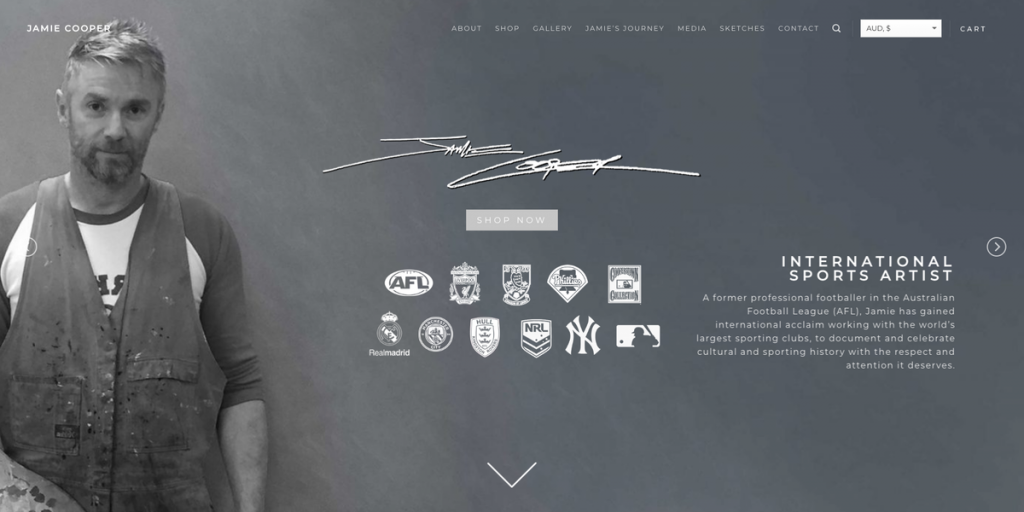
JCAP Australia — Jamie Cooper
Jamie Cooper is one of the most respected and talented sports artists in the country, having held Australian Football League (AFL), National Rugby League (NRL), Australian Cricket Board (ACB) and Australian Olympic Committee (AOC) memorabilia licenses.
JCAP Australia is an Australian based business, owned and operated by Jamie in Melbourne.
About JCAP Australia
Bugg Marketing Solutions (BMS) had been working with the Hong Kong Trade Development Council (HKTDC) for some time, and recognised the growing (and significant) opportunity that the Hong Kong International Licensing Show (HKILS) provides on a global scale. Hong Kong is an international hub for doing business and the HKILS is a perfect fit. BMS hosted the Australian Pavilion at the HKILS in January of 2014 and approached Jamie in August of 2013 with a focus on helping Jamie develop his business by exhibiting at the show.
The JCAP Interview
We recently had the opportunity to catch up with Jamie, some 7-months after the conclusion of the show. He had carried out his rigorous follow-up after the show and shared with us the JCAP Australia case study.
Jamie, when we first spoke to you last year after sending you the HKILS brochure, we discussed the opportunity and how it could benefit your business. In terms of the cost to exhibit, this show is reasonably priced. I know you had to consider other commercial costs to present your work in it’s best possible format. Can you tell us a little bit about what you needed to consider here?
What I need most, which is also the hardest to achieve, is direct access for myself, my art and to large sporting organisations around the world. The show for me was not about who walked in the door, but who was already there, in terms of other exhibitors. I knew several top European Football Clubs were exhibiting and that their licensing people would be attending the booths. This was a captive audience for me. It was worth putting some capital in to get in front of them.
I know that you place a lot of importance upon presentation of your work. Can you tell us a little bit about how you took the decision to go the extra step and present your work in it’s original format to give the best possible impression to your prospective clients?
I needed to present my concept and work in the flesh to have the most impact. To create a ‘wow’ factor, I felt the images should be near life size to the original art. So, I produced a number of large reproductions on canvas up to 3.5 meters long. These had to be transported to Hong Kong and then stretched around wooden frames (stretcher bars) to look and feel like real paintings. I sourced a small frame shop in Hong Kong to produce the frames and stretch the canvases. This was an expensive process, but the need to have the client understand the scale and impact of the artwork and to personally engage with it, was key to any chance of success. I created a mini-gallery in my booth.
In terms of making your decision to exhibit, I believe you were looking to target specific organisations in the sporting field. I believe that the HKTDC ‘business matching’ service was invaluable here. Can you tell us how this worked for you?
My sole reason for being at the show was to meet fellow exhibitors. Specifically to pitch my concept to the licensing departments of large European Football Clubs. The aim was to be able to introduce myself, and my work, then to pursue licensing deals to create artwork tailor-made for each club, with global rights to produce and distribute the reproductions. It was not to access the Asian market through people that might attend the show. The ‘business matching’ service gave me a guaranteed official introduction directly to the people that I needed to speak to in these organisations. I would never have had this kind of access contacting them out of the blue, AND, from so far away (Australia). Having them standing in front of my artwork whilst I sold my idea had a dramatic and vital impact.
I know you had a very well organised and rehearsed presentation platform during the show. What advice would you give to prospective exhibitors, in terms of engaging potential buyers whilst you have them on your stand?
You should know exactly what you are trying to communicate and achieve. Be excited about your product and have a very tangible plan as to how and what your product will do for the client. Also be open to client ideas as to how they see the product being applied for their needs. They may teach you something you didn’t know.
I believe you undertook some very extensive and exhaustive follow-up after the event. Can you tell us how important it is to commit the time and energy to a follow-up plan, in terms of closing a deal?
The follow-up is so important. I knew I had them engaged at the show, so I couldn’t afford to let that connection slip. Many people, especially in large organisations, have many things to focus on… so I had to keep the momentum going. I began discussions within a day of returning back to Australia. What followed was 8-months of communications and negotiations. It is still on-going!
Jamie, can you tell us how do you rate the HKILS, and more specially the marketing opportunities your presence at the show generated for you?
It is BY FAR the most effective marketing opportunity I have ever had. I could NEVER get 10 of Europe’s largest Football Clubs to sit in front of my work and hear my ideas, let alone all under one roof in the space of a week. Whether or not I end up signing multiple deals as a result of the show, the direct and personal access to globally significant clients has been priceless. The $10,000 AUD it cost me to be there is nothing compared to the exposure that it has given me.
An important part of closing a successful deal at an International Licensing Show is making the best possible impression in front of the right executives. Did this apply to your experience at the HKILS?
100%. Over the past five years I have tried emailing some of these clubs (and others) presenting the same artwork and concepts. It has nowhere near the same impact as meeting them in person does. I am in contract negotiations with one European Club at present; still negotiating terms with another and I currently have my work in front of four more for initial discussions.
Jamie, we really appreciate you taking the time to share your experience with us. We trust that this case study will encourage others to make the commitment to showcase their work at the HKILS in the future.
What Did We Learn?
- The best way to get results is face-to-face
- When presenting your work you need to be passionate
- Listen to your clients to understand and learn more
- Your investment will pay off if you have a sound plan
- Post-show follow-up is critical to closing deals
